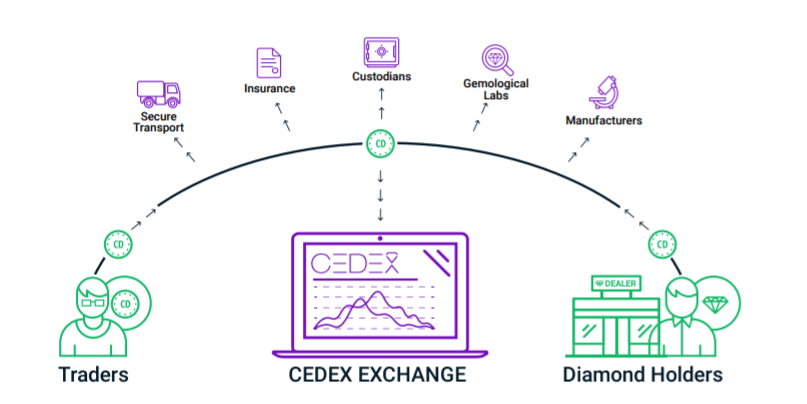
A diamond has long been seen as a precious commodity, accustomed with the rich and wealthy whilst also having a darker side that people tend to turn a blind eye to.
Despite its clear value, it has never really been considered as a lucrative or sustainable investment vehicle for firms or individual investors. Only 1% of the whole diamond market is attributed for investment purposes, leaving the remaining 99% for B2B trade and merchandise sales.
Diamonds Vs Other Commodities
Diamonds should definitely be considered in the same bracket as many other commodities. Gold being the obvious comparison, however if you were to take the whole gold market, 80% is used for investment purposes compared to the 1% of diamonds. Gold is classed as a safe haven asset, that investors flock to when they want to sell other products or assets. Should you hear of geopolitical unrest on the news, the chances are that the price of gold has increased.
So, why are diamonds not treated in a similar way to gold? There are problems with the diamond market.
Problems with diamond industry
Liquidity – The liquidity of the diamond market is very low. A few large companies have essentially monopolised it and are making the prices. When you compare that with gold, there are a lot more participants that can affect the price. Supply and demand forces affect the price more so than in diamonds. Until more investors participate in the market this will be difficult to change.
Fungibility – One of the main differences between gold and diamonds is the fact that no two diamonds are the same. One gold bar is the same as the next gold bar. Diamonds are more subjective.
Although evaluating diamonds is based on the four C’s; carat weight, cut, colour and clarity, deciphering between each one is difficult. Those that get paid to do so will have differing opinions, this in turn will affect the price of the same diamond between two separate appraisers. A two-carat diamond can be valued anywhere between $5,000 and $25,000. Standardising this is imperative to making the diamond market a more attractive market for investment firms and individuals.
Transparency – The diamond market has always had transparency issues, often the process from discover to final sale is littered with sordid details. Details that are kept well hidden. Being able to keep track of every transaction would make the market considerably more attractive to potential investors.
CEDEX the solution
CEDEX is a company that has designed answers to these questions. Using blockchain technology based on the Ethereum platform, they provide decentralised security for users, meaning that transparency is increased.
Blockchain technology is the innovation that a public network can be secured by trust and that once everyone agrees, an addition can be made to the blockchain. This means a public ledger of transactions that anyone can access. Transactions are therefore recorded, and it is visible who bought what and when. This transparency will begin taking down some of the bad attention the diamond market receives.
CEDEX’s Token Alternative
CEDEX will launch a token, the ERC-20 token. This will act as the primary currency for all diamond transactions, not only that but also services used by the diamond market, transportation, insurance, plus more will be exchangeable with the token.
Having a token will automatically increase liquidity, taking away some of the power those at controlling companies may have over the price of diamonds.
How does the ERC-20 compare with other cryptocurrencies?
Cryptocurrencies will essentially be judged by the underlying assets value. Currently there are a lot of cryptocurrencies on the market that have an idea that a company are working towards. However, this is not set in stone, this idea may fail.
In contrast, the CEDEX coin is poised to make an immediate impact. The fact that a market already exists, makes implementing the exchange easier than other cryptocurrencies.
CEDEX’s Algorithm Alternative
CEDEX has also developed a machine learning algorithm, the DEX. This will be used to evaluate diamonds, standardising each one and making the value less subjective. It uses data collected from the Gemological Institute of America (GIA) to assess each diamond based on its gemological purity, parallel composite and indices composite. The DEX brings a new level of standardization to diamond pricing, with a pricing accuracy rate of over 99.5%.
Who benefits?
This creates a market of two sides. Dealers and private holders. With a new distribution channel for their inventories, large dealers have already expressed their interest in CEDEX.
For those private holders, they will finally have a place where they can sell their diamonds for a fair price.
New investors
With both these solutions, CEDEX will likely attract other types of investors to the diamond market.
Those investors that buy other commodities, those gold investors will see value in the diamond market. It will likely be used as a similar investment vehicle as these commodities and used to hedge against inflation and the stock market. It may eventually bring about diamonds as a safe haven commodity.
The introduction of more participants into the market increases liquidity and again means that buyers and sellers will get a fairer price.


